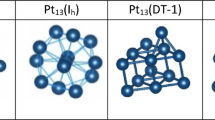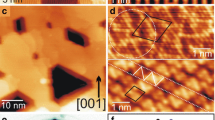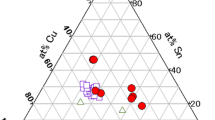Abstract
The growing interest in a material composed of Cu single atoms and/or their sub-nanometric clusters deposited on titania prompted us to perform systematic theoretical studies on the system comprising the anatase phase of titania, modelled by a (TiO2)34 cluster with copper particles of 1–7 atoms on top of it. The ground-state geometric structures were proposed and compared with the available literature data derived from EXAFS experiments done for Cu-TiO2 materials. Copper atoms prefer to aggregate and form larger clusters on TiO2, as seen from the computed nucleation energies. The models were characterised by the following electronic properties: electronic band structure, natural population charges, and frontier orbitals (HOMO, LUMO, and SOMO). The copper phase becomes oxidised once it is deposited on titania. The charge distribution in the resulting structures indicates that the atoms that are the closest to the Cu-TiO2 interface would become the active sites for catalytic processes; copper atoms would act as electrophilic, while oxygen atoms would act as nucleophilic. The calculated binding energies between the two phases show that the formation of the composite system is favourable from the thermodynamic point of view, and the interaction between the small copper clusters and the titania surface is mostly of electrostatic nature.







Similar content being viewed by others
Data availability
The datasets generated during and/or analysed during the current study are available from the corresponding author upon reasonable request.
References
Ganesh I et al (2014) Preparation and characterization of Cu-doped TiO2 materials for electrochemical, photoelectrochemical, and photocatalytic applications. Appl Surf Sci 293:229–247
Xin B et al (2008) Effect of surface species on Cu-TiO2 photocatalytic activity. Appl Surf Sci 254(9):2569–2574
Bensouici F et al (2017) Optical, structural and photocatalysis properties of Cu-doped TiO2 thin films. Appl Surf Sci 395:110–116
Chang S-M, Liu W-S (2014) The roles of surface-doped metal ions (V, Mn, Fe, Cu, Ce, and W) in the interfacial behavior of TiO2 photocatalysts. Appl Catal B 156–157:466–475
Alotaibi AM et al (2020) Enhanced photocatalytic and antibacterial ability of Cu-doped anatase TiO2 thin films: theory and experiment. ACS Appl Mater Interfaces 12(13):15348–15361
Cheng C et al (2021) Water splitting with a single-atom Cu/TiO2 photocatalyst: atomistic origin of high efficiency and proposed enhancement by spin selection. JACS Au 1(5):550–559
Lee B-H et al (2019) Reversible and cooperative photoactivation of single-atom Cu/TiO2 photocatalysts. Nat Mater 18(6):620–626
Obregón S et al (2015) Cu–TiO2 systems for the photocatalytic H2 production: Influence of structural and surface support features. Appl Catal B 179:468–478
Adekoya DO, Tahir M, Amin NA (2017) g-C3 N4/(Cu/TiO2) nanocomposite for enhanced photoreduction of CO2 to CH3OH and HCOOH under UV/visible light. J CO2 Utilization 18:261–274
Pascariu P, Cojocaru C, Samoila P, Airinei A, Olaru N, Rotaru A, Romanitan C, Tudoran LB, Suchea M (2022) Cu/TiO2 composite nanofibers with improved photocatalytic performance under UV and UV–visible light irradiation. Surf Interfaces 28
Wu N (2004) Enhanced TiO2 photocatalysis by Cu in hydrogen production from aqueous methanol solution. Int J Hydrogen Energy 29(15):1601–1605
Ren C, Li Q, Ling C, Wang J (2023) Mechanism-guided design of photocatalysts for CO2 reduction toward multicarbon Pproducts. J Am Chem Soc 2023
Xu S et al (2010) Fabrication and comparison of highly efficient Cu incorporated TiO2 photocatalyst for hydrogen generation from water. Int J Hydrogen Energy 35(11):5254–5261
Neatu S, Macia-Agullo JA, Garcia H (2014) Solar light photocatalytic CO2 reduction: general considerations and selected bench-mark photocatalysts. Int J Mol Sci 15(4):5246–5262
Macià Escatllar A, Morales-García Á, Illas F, Bromley ST (2019) Efficient preparation of TiO2 nanoparticle models using interatomic potentials. J Chem Phys 150(21)
Cho D et al (2016) Effect of size and structure on the ground-state and excited-state electronic structure of TiO2 nanoparticles. J Chem Theory Comput 12(8):3751–3763
Cho D et al (2017) Correction to effect of size and structure on the ground-state and excited-state electronic structure of TiO2 nanoparticles. J Chem Theory Comput 13(11):5822–5822
Lamiel-Garcia O et al (2017) When anatase nanoparticles become bulklike: properties of realistic TiO2 nanoparticles in the 1–6 nm size range from all electron relativistic density functional theory based calculations. J Chem Theory Comput 13(4):1785–1793
Perron H et al (2007) Optimisation of accurate rutile TiO2 (110), (100), (101) and (001) surface models from periodic DFT calculations. Theoret Chem Acc 117(4):565–574
Wei B, Calatayud M (2022) Hydrogen activation on Anatase TiO2: effect of surface termination. Catal Today 397–399:113–120
Navas J et al (2014) Experimental and theoretical study of the electronic properties of Cu-doped anatase TiO2. Phys Chem Chem Phys 16(8):3835–3845
Wang Y et al (2020) Mechanistic understanding on the role of Cu species over the CuOx/TiO2 catalyst for CO2 photoreduction. ACS Omega 5(29):18050–18063
Barlocco I, Maleki F, Pacchioni G (2023) CO2 Activation on Cu/TiO2 nanostructures: importance of dual binding site. Chemistry 29(36):e202300757
Sharma PK et al (2019) Surface modification of TiO2 with copper clusters for band gap narrowing. Catal Today 321–322:9–17
Kalantari L, Tran F, Blaha P (2021) Density Functional Theory Study of Metal and Metal-Oxide Nucleation and Growth on the Anatase TiO2 (101) Surface. Computation 9(11):125
Yao GY, Zhao ZY, Liu QL, Dong XD, Zhao QM (2020) Theoretical calculations for localized surface plasmon resonance effects of Cu/TiO2 nanosphere: generation, modulation, and application in photocatalysis. Solar Energy Mater Solar Cells 208
Wang X et al (2021) Thermodynamic insights into strong metal–support interaction of transition metal nanoparticles on titania: simple descriptors for complex chemistry. J Mater Chem A 9(7):4044–4054
Dirac PA (1929) Quantum mechanics of many-electron systems. Proceedings of the Royal Society of London. Series A 123(792):714–733
Slater JC (1951) A simplification of the Hartree-Fock method. Phys Rev 81(3):385–390
Perdew JP, Burke K, Ernzerhof M (1996) Generalized gradient approximation made simple. Phys Rev Lett 77(18):3865–3868
Perdew JP, Wang Y (1992) Accurate and simple analytic representation of the electron-gas correlation energy. Phys Rev B 45(23):13244
Grimme S et al (2010) A consistent and accurate ab initio parametrization of density functional dispersion correction (DFT-D) for the 94 elements H-Pu. J Chem Phys 132(15):154104
Lin L, Shi Z, Huang J, Wang P, Yu W, He C, Zhang Z (2020) Molecular adsorption properties of CH4 with noble metals doped onto oxygen vacancy defect of anatase TiO2 (1 0 1) surface: first-principles calculations. Appl Surface Sci 514
Weigend F, Ahlrichs R (2005) Balanced basis sets of split valence, triple zeta valence and quadruple zeta valence quality for H to Rn: design and assessment of accuracy. Phys Chem Chem Phys 7(18):3297–3305
Eichkorn K et al (1997) Auxiliary basis sets for main row atoms and transition metals and their use to approximate Coulomb potentials. Theoret Chem Acc 97:119–124
Eichkorn K et al (1995) Auxiliary basis sets to approximate Coulomb potentials. Chem Phys Lett 240:283–289
TURBOMOLE V6.3 2011 (2007) A development of University of Karlsruhe and Forschungszentrum Karlsruhe GmbH, 1989-2007, TURBOMOLE GmbH. Available from http://www.turbomole.com
Reed AE, Weinstock RB, Weinhold F (1985) Natural population analysis. J Chem Phys 83(2):735–746
Chen H-YT, Tosoni S, Pacchioni G (2014) Adsorption of ruthenium atoms and clusters on anatase TiO2 and tetragonal ZrO2(101) surfaces: a comparative DFT study. J Phys Chem C 119(20):10856–10868
Deraet X et al (2023) Understanding the reactivity of supported late transition metals on a bare anatase (101) surface: a periodic conceptual DFT investigation. Chem Phys Chem 24(6)
Catlow CRA et al (2003) Understanding the interface between oxides and metals. Faraday Discuss 124:185
Sudrajat H, Nguyen TK (2020) Key factors controlling the durability of a Cu-doped TiO2 photocatalyst. Optik 217:64914
Li W (2015) Influence of electronic structures of doped TiO2 on their photocatalysis. Physica status solidi (RRL)–Rapid Res Lett 9(1):10-27
Castro-Latorre P, Neyman KM, Bruix A (2023) Systematic characterization of electronic metal-support interactions in ceria-supported Pt particles. J Phys Chem C 127(36):17700–17710
Böyükata M, Belchior JC (2008) Structural and energetic analysis of copper clusters: MD study of Cun (n = 2–45). J Braz Chem Soc 19(5):884–893
Erkoç Ş, Shaltaf R (1999) Monte Carlo computer simulation of copper clusters. Phys Rev A 60(4):3053–3057
Grigoryan VG, Alamanova D, Springborg M (2006) Structure and energetics of CuN clusters with (2 ≤ N ≤ 150): an embedded-atom-method study. Phys Rev B 73(11):115415
Acknowledgements
This publication is based upon work from COST Action CA 18234, ‘Computational materials sciences for efficient water splitting with nanocrystals from abundant elements’, supported by COST (European Cooperation in Science and Technology).
Funding
This work was supported by the National Science Centre, Poland, within the Solar-Driven Chemistry project No. 2019/01/Y/ST4/00024. A. D.-M. would like to thank the statutory funds of the Jerzy Haber Institute of Catalysis and Surface Chemistry PAS. We gratefully acknowledge Polish high-performance computing infrastructure PLGrid (HPC Centers: ACK Cyfronet AGH) for providing computer facilities and support within computational grant No. PLG/2020/013927.
Author information
Authors and Affiliations
Contributions
All authors contributed to the study conception and design as well as data analysis. Data collection was performed by Dorota Rutkowska-Zbik, and the first draft of the manuscript was written by Dorota Rutkowska-Zbik. All authors commented on previous versions of the manuscript. All authors read and approved the final manuscript.
Corresponding author
Ethics declarations
Competing interests
The authors declare no competing interests.
Additional information
Publisher's Note
Springer Nature remains neutral with regard to jurisdictional claims in published maps and institutional affiliations.
Rights and permissions
Springer Nature or its licensor (e.g. a society or other partner) holds exclusive rights to this article under a publishing agreement with the author(s) or other rightsholder(s); author self-archiving of the accepted manuscript version of this article is solely governed by the terms of such publishing agreement and applicable law.
About this article
Cite this article
Rutkowska-Zbik, D., Drzewiecka-Matuszek, A. & Tokarz-Sobieraj, R. From single Cu atoms to sub-nanometric copper clusters deposited on TiO2: a DFT study. Struct Chem (2024). https://doi.org/10.1007/s11224-024-02288-3
Received:
Accepted:
Published:
DOI: https://doi.org/10.1007/s11224-024-02288-3




